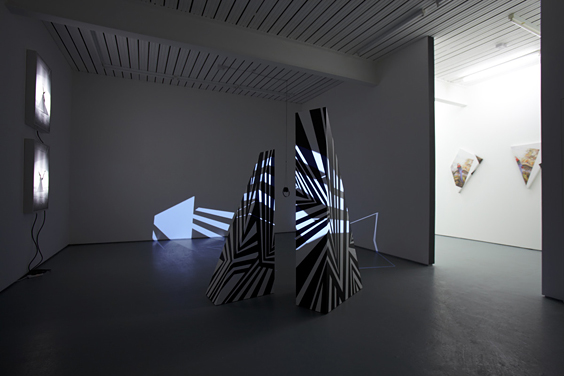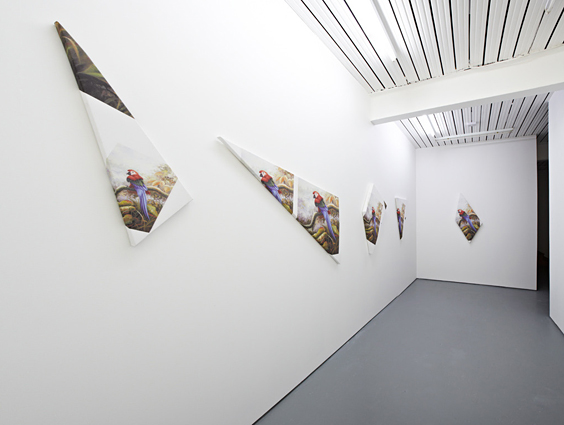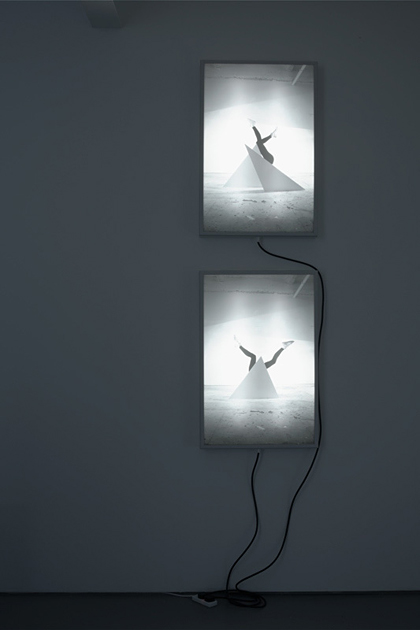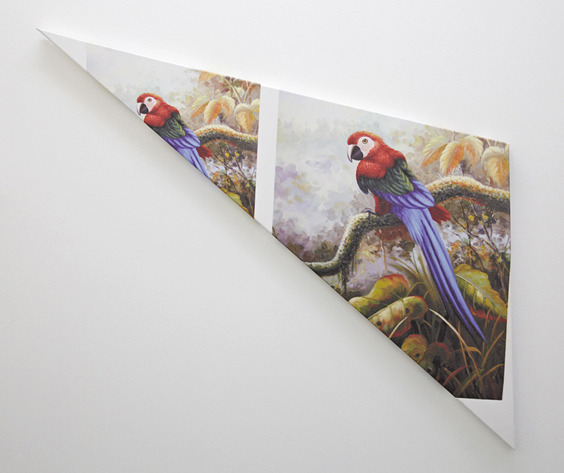
Yasmin Müller, Copia: Modern Disbelief, 2012. Installation view. Courtesy the artist and Maria Stenfors
Text by Ursula Ströbele
Copia – the name of the Roman goddess of abundance– is at the same time a term of the antique rhetoric which means pool, mass, opulence, and a wealth of knowledge and ideas.
In Alberti’s well known treatise of painting (1435), copia sits beside varietas (variety) and electio (selection) as the most important criteria for a successful composition: While copia causes “attentive consideration of the represented objectsâ€, varietas guarantees a figurative and gestural diversity. Copia runs the risk of being “a tumultuous accumulationâ€, which may be averted by the electio, the deliberate action of an appropriate choice for each subject.
“Copia. Modern disbelief†– Yasmin Müller’s second solo exhibition at Maria Stenfors, presents new works in differing media, amongst them being two illuminated light boxes and an architectural installation enveloped in light projections – appearing to be a random arrangement of disparate found objects and shaped canvases.
At first glance the space seems to be streaked by a purist geometric expansive pattern, at second glance a multi-faceted net of images open up, evoking a host of associations and permitting individual interpretations.
In one of the core issues, the artist makes a critical observation of the fundamental question of the existence of originality and its chameleon-like relationship towards the copy, closely connected to the dialectic of idealism verses conformity. What is the “I� How does identity arise? How does a successful self-identification function?

Yasmin Müller, Copia: Modern Disbelief, installation view 2012. Courtesy the artist and Maria Stenfors
The predominant codification, by using external requisites underlines the performative character of our everyday life and the world as theatre (Theatrum mundi) – since the Baroque, a common metaphor of the vanity and frivolity of human gestures. This continuous Mise-en-Scene of each individual within a changing socio-political environment and their definition through recognizable, categorisable signs is embodied concisely by fashion. It evokes the paradoxical situation of searching for stability through variation, striving for singularity with the awareness of not being alone on this path.
The observing reflection of the “Iâ€, as well as the stringent adherence of a specific imagination is an essential precondition; the originality of the imitation is thereby based on the “correct†selection and coevally on one’s own invention.
The Italian sociologist Elena Esposito points out this contradictory situation in her book “The bindingness of the transient. Paradoxes of fashion†(2004): “Only by masking oneself, the self is gained, because the use of the mask enables to relieve/deliberate the true identity of the disguised person, and respectively this exposes the real relationships between the individuals.â€
The French coining of the term “la mode†as a sign of a growing standardized awareness of clothes during the 17th century is also reflected in the baroque idea of the mask, which deals exactly with this double sense of concealing and revealing art. The veiling of the medium manifests the triumph of a specific artistic knowledge. “Modern disbelief†subjects the fixation of the transient to negotiation, including its irrevocable paradigms, as Yasmin Müller drafts in her pictorial language, partly influenced by the American Minimal Art, partly by Postmodernism ideals. She always keeps in view that the desire of individuality arises out of pre-existing uniformity and in the end returns back to this root in a vicious circle.

Yasmin Müller, Lola Scalp I (top) and Lola Scalp II (bottom), 2012. Plexiglass and aluminium lightbox. Courtesy the artist and Maria Stenfors.
The light boxes, presented in the smaller room of the gallery, comment on this polarity of concealing and unveiling – two black and white photographs with white coloured aluminium frames. Their presentation is reminiscent of seductive luminous advertising as well as of a processed, illuminated version of the traditional panel painting. They show each a pair of legs in black leggings and feet in white sneakers – both of them prototypes of a predominant fashion trend during recent years. The corresponding body remains hidden behind triangles. The bent stance of the legs, stretched high, retraces the geometric form and denies an immediate alignment like in Valie Export’s “Body configurations†of the 1980s. The artist, well-known for her feminist performances, picks up the vocabulary of the masculine representational architecture, as the body – contrary to its anatomy – nestles into building elements, such as round facades or stairs. It takes a subordinate role and mutates into ornamental decoration. In Müller’s work the protagonist refrains from a similar deformation and mimicry. With Derrida’s comparison of parergon/ergon, one could ask, who actually is the frame and who is the framed? Body and object are situated in a suspended relationship and melt into a sculptural ensemble, whose plastic effect is counteracted by the two- dimensionality of the photographic print. While overlapping different media, the physical presence is alienated by a graphic effect – emphasised by the wrinkle-free and close-fitting fabric of the leggings and the reduced shapes of colour in the scenery.
The wide-spread arrangement in the middle of the big space, including accidentally draped studio items and external found objects, is dominated by two more, approximately body-sized triangular objects. Their surface is covered with a black and white camouflage pattern in the style of razzle-dazzle from the British vorticists and utilized in warfare engineering. They confront the viewer as staffage-like, abstract ruins by marking traces of a present absence and playing an illusionistic game between plane and depth. The all-overlaying, geometric light pattern, which absorbs everybody entering the gallery, obscures the spatial contours, directs the perception and only allows a single perspective – according to the selection of the copia. Is this palimpsest overlap coexistent as a metaphor of the complex, unmanageable structure of our society, which makes disbelief an indispensable impetus and survival strategy?
Ursula Ströbele is a curator, writer and researcher based in Berlin. Ströbele also teaches at Universität der Künste, Berlin.

Yasmin Müller, Joe, 2012. digital print on canvas. Courtesy the artist and Maria Stenfors
Yasmin Müller
Copia: Modern Disbelief
5 October – 10 November 2012
Maria Stenfors
Unit 10, 21 Wren Street
London WC1X 0HF
www.mariastenfors.com
Opening hours
Tuesday – Friday 11.00 am – 6.00 pm
Saturday 11.00 am – 3.00 pm
Or by appointment.
